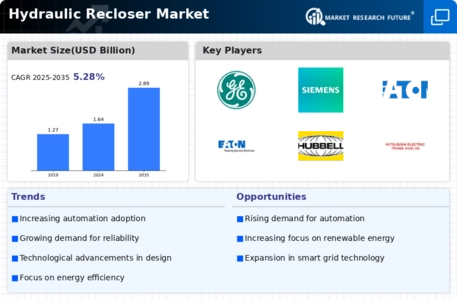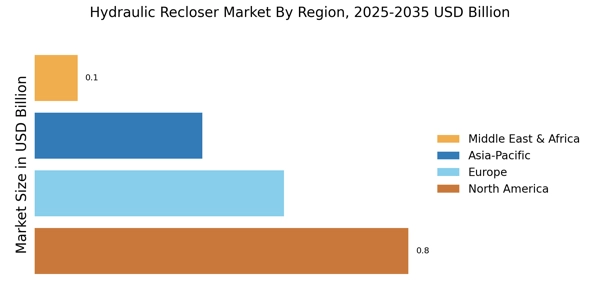Integration of Smart Grid Technologies
The integration of smart grid technologies is a pivotal driver for the Hydraulic Recloser Market. Smart grids enhance the efficiency and reliability of electricity distribution, and hydraulic reclosers are integral to this transformation. These devices facilitate real-time monitoring and automated fault detection, which significantly reduces outage times. The adoption of smart grid solutions is expected to increase, with investments in this sector reaching billions of dollars. As utilities seek to modernize their infrastructure, the demand for hydraulic reclosers that can seamlessly integrate with smart grid systems is likely to rise. This trend not only improves operational efficiency but also aligns with the broader goals of energy management and sustainability.
Growing Focus on Renewable Energy Sources
The Hydraulic Recloser Market is also influenced by the growing focus on renewable energy sources. As countries strive to meet their energy needs through sustainable means, the integration of renewable energy into existing grids becomes essential. Hydraulic reclosers are vital in managing the variability associated with renewable energy sources such as wind and solar. They help maintain grid stability by quickly isolating faults and restoring service, which is crucial for the reliability of renewable energy systems. The increasing penetration of renewables is expected to drive the demand for hydraulic reclosers, as utilities require advanced solutions to handle the complexities of modern energy distribution.
Increasing Demand for Reliable Power Supply
The Hydraulic Recloser Market is experiencing a surge in demand for reliable power supply solutions. As urbanization accelerates, the need for uninterrupted electricity becomes paramount. Hydraulic reclosers play a crucial role in enhancing the reliability of power distribution networks by automatically restoring power after transient faults. This capability is particularly vital in regions prone to weather-related disruptions. According to recent data, the market for hydraulic reclosers is projected to grow at a compound annual growth rate of approximately 6% over the next five years. This growth is driven by the increasing investments in smart grid technologies and the modernization of aging electrical infrastructure, which necessitate the integration of advanced recloser systems.
Regulatory Support for Infrastructure Upgrades
Regulatory support for infrastructure upgrades is a significant driver for the Hydraulic Recloser Market. Governments worldwide are implementing policies that encourage the modernization of electrical grids to enhance reliability and safety. These regulations often mandate the adoption of advanced technologies, including hydraulic reclosers, to improve fault management and reduce outage durations. As utilities comply with these regulations, the demand for hydraulic reclosers is likely to increase. Furthermore, funding initiatives aimed at upgrading aging infrastructure are expected to bolster market growth, as utilities seek to invest in technologies that align with regulatory requirements and improve service delivery.
Rising Investment in Electrical Distribution Networks
Rising investment in electrical distribution networks is a key driver for the Hydraulic Recloser Market. As the demand for electricity continues to grow, utilities are compelled to enhance their distribution networks to ensure reliability and efficiency. This investment trend is reflected in the increasing allocation of funds towards upgrading existing infrastructure and implementing advanced technologies. Hydraulic reclosers are becoming a preferred choice for utilities looking to improve their fault management capabilities. The market is projected to witness substantial growth, with investments in distribution networks expected to reach unprecedented levels in the coming years. This trend underscores the critical role of hydraulic reclosers in modernizing electrical distribution systems.


















Leave a Comment